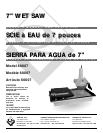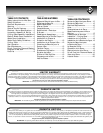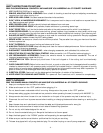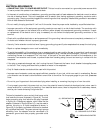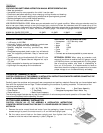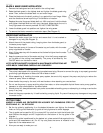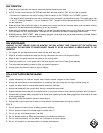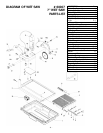
- 3 -
SAFETY INSTRUCTIONS FOR WET SAW
READ THIS OWNERS MANUAL COMPLETELY AND MAKE SURE YOU UNDERSTAND ALL OF ITS SAFETY GUIDELINES.
1. KEEP GUARDS IN PLACE and in working order.
2. REMOVE ADJUSTING KEYS & WRENCHES. Form a habit of checking to see that keys and adjusting wrenches are
removed from tool before turning it on.
3.
KEEP WORK AREA CLEAN. Cluttered areas and benches invite accidents.
4. DON’T USE IN A DANGEROUS ENVIRONMENT. Don’t use power tools in damp or wet locations or expose them to
rain. Keep work area well lighted.
5. KEEP CHILDREN AWAY. All visitors should be kept safe distance from work area.
6. MAKE WORKSHOP KID-PROOF with padlocks, master switches or by removing starter keys.
7. DON’T FORCE TOOL. It will do the job better and safer at the performance level for which it was designed.
8. WEAR PROPER APPAREL. Do not wear loose clothing, gloves, neckties, rings, bracelets or other jewelry which may
get caught in moving parts. Non-slip foot wear is recommended. Wear protective hair covering if you have long hair.
9.
ALWAYS USE SAFETY GLASSES. Also use face or dust mask for commercial cutting operations. Everyday eyeglasses
only have impact-resistant lenses, they NOT safety glasses.
10.
SECURE WORK. Use clamps or a vise to hold work when practical. They are safer than using your hand and free both
hands to operate tool.
11.
DON’T OVERREACH. Keep proper footing and balance at all times.
12.
MAINTAIN TOOLS WITH CARE. Keep tools sharp and clean for best and safest performance. Follow instructions for
lubricating and changing accessories.
13. DISCONNECT TOOLS BEFORE SERVICING – when changing accessories, such as blades, bits, cutters, etc.
14. REDUCE THE RISK OF UNINTENTIONAL STARTING. Make sure switch is in OFF position before plugging in.
15. USE RECOMMENDED ACCESSORIES. Consult the owner’s manual for recommended accessories. The use of
improper accessories may cause risk of injury.
16.
NEVER STAND ON TOOL. Serious injury could occur if the tool is tipped or if the cutting tool is unintentionally
contacted.
17. CHECK DAMAGED PARTS. Before further use of the tool, a guard or other part that is damaged should be carefully
checked to determine that it will operate properly and perform its intended function – check for alignment of moving
parts, binding of moving parts, breakage of parts, mounting and any other conditions that may affect is operation. A
guard or other part that is damaged should be properly repaired or replaced.
18.
DIRECTION OF FEED. Feed work into the blade against the direction of rotation of the blade only.
19. NEVER LEAVE TOOL RUNNING UNATTENDED. Turn power off. Don’t leave tool until it comes to a complete stop.
ENGLISH
SAFETY GUIDELINES
READ THIS OWNER’S MANUAL COMPLETELY AND MAKE SURE YOU UNDERSTAND ALL OF ITS SAFETY GUIDELINES.
1. Keep your workspace clear and free of all debris.
2. Make sure the saw is in the “OFF” position before plugging it in.
3. Do not leave the saw unattended while it is running. Always return the power to the “OFF” position.
4. Always wear safety goggles, dust mask and ear protection when operating the saw (to comply with ANSI-Z87.1).
5. Always remain alert when the saw is in use. Inattention on the part of the operator may lead to serious injury.
6. Disconnect the unit from its power source before installing or changing blades and before cleaning or servicing the
saw.
7. Keep the saw clean and maintained to achieve the safest and highest performance for every job.
8. Ensure that a continuous flow of water to both sides of blade during operation.
9. Do not cut dry with blades designed for wet cut.
10. Do not force the material being cut. Always let the blade cut at its own speed.
11. Keep the blade guard in the “DOWN” position while operating the saw specification.
12. Make sure you use the correct blade or profile wheel for the job you are doing.
13. This saw is equipped with a 3-prong electrical plug. Do not alter the plug or use a 2-prong receptacle.



